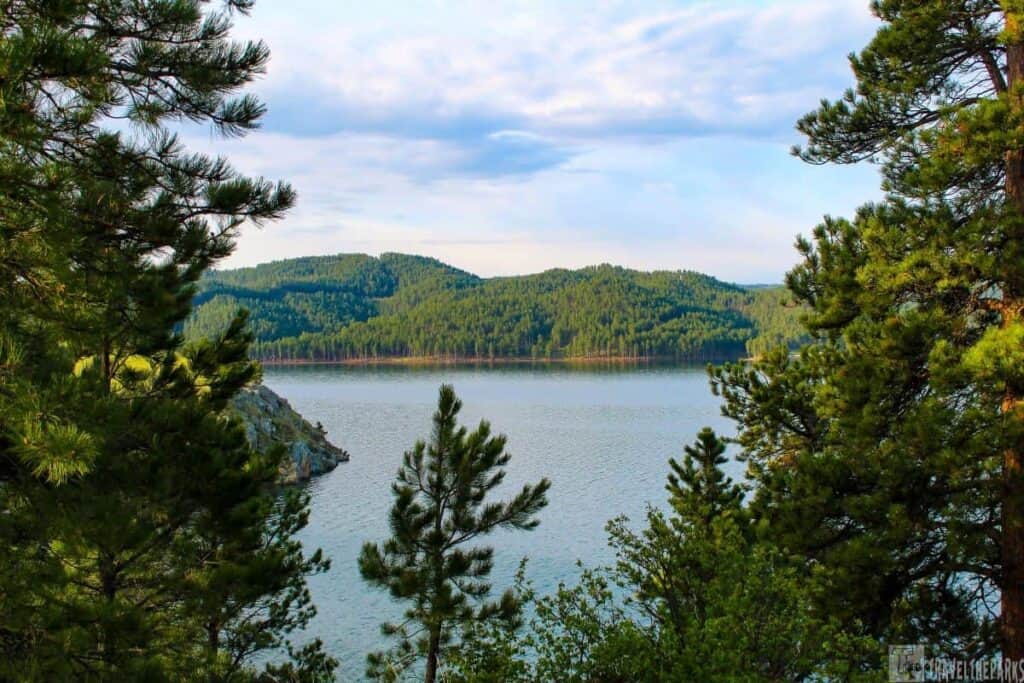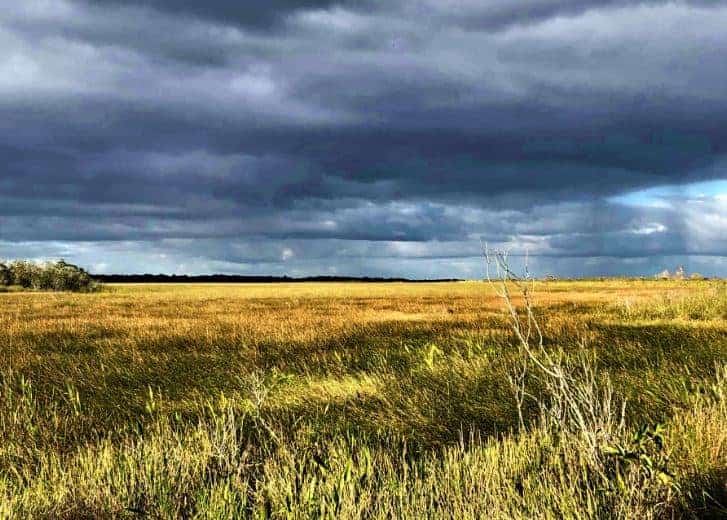As many of you know, we love to discover new places. In the heart of North Dakota, we explored the many hidden gems in the charming town of Medora. There is a quaint western vibe in this town just outside the southern gateway to Theodore Roosevelt National Park (TRNP). Although it is small, it has plenty to offer visitors looking to explore the national park. If you are looking to extend your stay, planning a day in Medora to explore is well worth it.
This post may contain affiliate links, meaning if you purchase something through one of these links, we may earn a small commission at no extra cost to you! Read the full disclosure policy here.

Medora exudes a timeless charm steeped in western heritage. We were glad we made the stop on our return from the park to enjoy a bit of modern-day hospitality. We found we fell in love with the quaint shops, welcoming locals, and a palpable sense of history. Medora is more than just a stopover—it’s an experience in itself.

Table of Contents
Getting to Medora North Dakota
By Air: The closest airport to Medora is Dickinson – Theodore Roosevelt Regional Airport (DIK), about 35 miles away. From there, you can rent a car or take a taxi to Medora.
By Car: Medora is just off Interstate 94, making it easy to reach by car. From the east, take Exit 261 and follow the signs to Medora. From the west, take Exit 259 and follow the signs to Medora.

Theodore Roosevelth National Park: A Natural Masterpiece
Before we soaked in the Medora magic, we venture into the badlands of Theodore Roosevelt National Park. Known for its rugged buttes and distinct wildlife, TRNP promised us an unforgettable outdoor experience.
We began our day with a quick stop at the Painted Canyon Visitor Center. The Painted Canyon Visitor Center is a great place to start your exploration of Theodore Roosevelt National Park’s South Unit. Open from 8:30 AM to 5:00 PM, seven days a week, from mid-March to mid-October. It is the prefect place to find information and maps for the park. A moderate 4.2-mile out-and-back trail into the canyon got us up close to the badlands’ buttes, bypassing the bison herds we met along the way. Just remember, the hike down is easy. The hike back out was not so much. Bring plenty of water and snacks, as there are no concessions at the visitor center. Dress in layers, as the weather can change rapidly in the Badlands.

TRNP Scenic Drive: The Painted Canyon Loop
We drove to the scenic Painted Canyon Loop in the early morning to avoid the crowds. Through the park’s South Unit, the drive winds. The park’s many viewpoints treat you to panoramic views of colorful badlands and the Little Missouri River. The Wind Canyon, Coal Vein and Old Entrance Trails were our favorites. Wear sturdy hiking boots with good traction to navigate the uneven terrain and bring bug spray for the flying insects. Don’t forget your camera—the vibrant hues of the canyon are a photographer’s dream. On the trails, we kept our eyes peeled for the park’s resident wildlife. Bison roam freely, wild horses graze in the distance, and prairie dogs pop up to say hello everywhere. TRNP is a haven for nature enthusiasts and wildlife photographers alike.

Discover the Magic of Medora: Things to See and Do
While TRNP is the star of the show, Medora has its own set of hidden gems waiting to be discovered. Take a stroll down the Historic Medora Walking Tour, where well-preserved historic sites and fascinating stories await.

Don’t Miss: Harmony in the Badlands The Medora Musical
Medora Musical kicked off our Medora adventure. Although it is touristy, it tells a story about Theodore Roosevelt in the Badlands in this outdoor musical. It includes country, western, and Broadway show tunes performed by talented singers, dancers, and musicians. Special effects include horseback riding, trick riding, and pyrotechnics. Don’t miss out on this exciting musical journey through the region’s history. It is the perfect way to immerse yourself in the spirit of the Wild West.
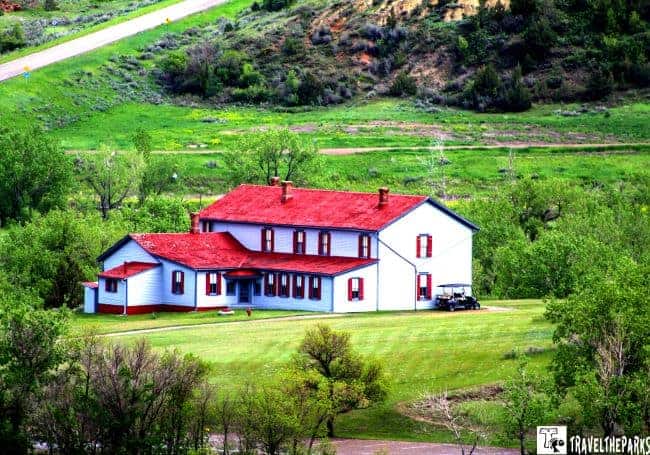
Discover the Chateau de Mores Historic Site: A Glimpse into the Past
The Chateau de Mores State Historic Site is a 128 acre site which includes Chimney Park and de Mores Memorial Park. The State Historical Society of North Dakota operates the site. We began our exploration of the Chateau de Mores Historic site with a quick stop at the interpretive museum. The interpretive center is open daily, year-round. It provided us with an introduction into the Marquis de Mores, Antoine de Vallombrosa, who came to the Badlands of North Dakota in the 1880s. A short film and exhibit explains his desire to build a cattle enterprise which inevitably failed. We also learned he named the town “Medora” in honor of his wife (Medora von Hoffman).

The French nobleman built the Chateau de Mores as a hunting lodge and summer home in 1883. Our self-guided tour of Chateau de Mores included the two-story, 26,000-square-foot, 26-room mansion that was once the Marquis de Mores’ home. Informational cards explain the significant features of each room. Many rooms have the family’s original furnishings and personal effects. We got a glimpse of Medora’s rich history as we wandered through its beautifully restored rooms and gardens. The most notable feature for me was the spirit tea kettles in the living room. My favorite feature was the spirit tea kettles in the living room. It was as if they would serve afternoon tea at any moment.

Chimney Park a Lasting Legacy
Upon exiting the south entrance of Theodore Roosevelt National Park, we saw a lone brick chimney. Taking a left, we came upon Chimney Park. It’s a nice park with a picnic area and interpretive signs that tell the story of the Marquis de Mores’ meat packing plant. Informational placards tell the story of how the plant burned down in 1907. All that remains today are the foundations of the slaughterhouse, the icehouse, part of the rail spur, a corral and the singular clay chimney.

Riding into History: Exploring the Legacy of North Dakota Cowboy Hall of Fame
If you’re in Medora, check out the Cowboy Hall of Fame. Open from 10:00 AM to 5:00 PM, 7 days a week, from Memorial Day weekend through Labor Day weekend, it is the best place to learn about the North Dakota American West.. With a torrential rainstorm outside, we gladly paid a small entrance fee and spent a few hours walking through the displays. The first-floor galleries featured exhibits on the history of northern plains indigenous peoples. Many of the preserved artifacts showcase the Lakota heritage and hardships faced by early homesteaders. There’s an entire section dedicated to regional rodeos and ranching.
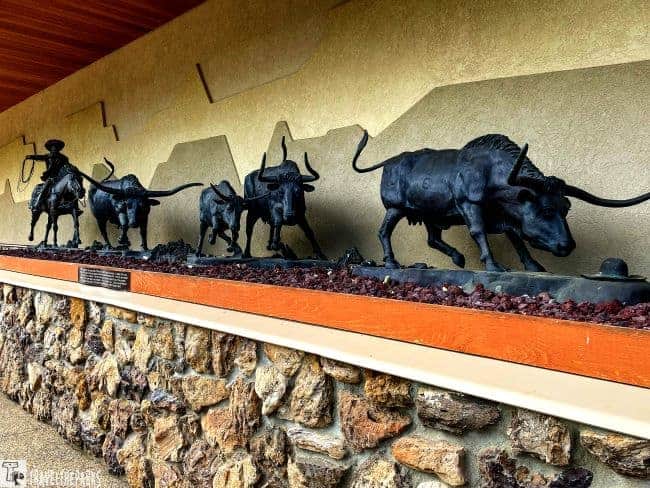
North Dakota’s cowboy culture and heritage are honored on the upper floor of the museum. Cowboys, cowgirls, and livestock from North Dakota are celebrated. There’s also a collection of memorabilia dedicated to horsemanship and the rodeo. Bronze sculptures by renown artists Frederick Remington, Lorenzo Ghiglieri and Laran Gighlieri are on display in many of the rooms. Every summer, the museum recreates living history with blacksmithing, rope making, and saddle making displays.
In the Center of Western Heritage & Cultures theater, you can see documentaries about the American West. There’s a lot of interesting stuff in the gift shop. We got some great advice from the staff about things to do in Medora. We were so pleased spending our afternoon here.

Footstep of the Past: Self Guided Walking Tour of Medora
The Medora town area only covers a few blocks. Streets are in a grid pattern. We started out walk at the town square in a clock-wise direction. The town has done an outstanding job of placing interpretive signs at all the historically relevant buildings. Each details the background information and historical significance of each area. We wandered through, just imagining what it must have looked like during Roosevelt’s time. Apply plenty of sunscreen and carry a refillable water bottle in the warmer months.
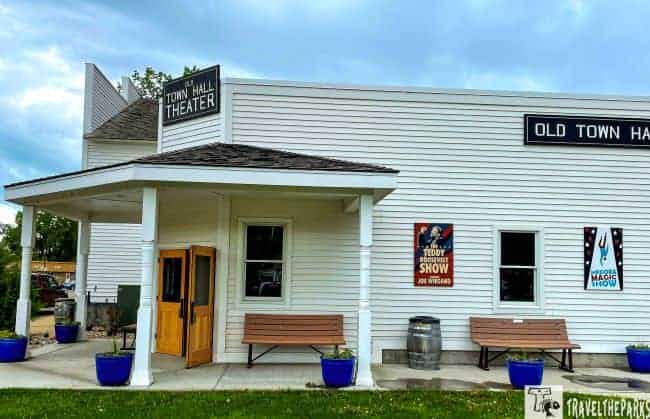
Stop #1-Old Town Theater
The Old Town Hall Theater is a beautiful theater that hosts a variety of shows, from historical dramas to musical performances. One of the best performances we watched tells the story of Theodore Roosevelt’s life and his time in the Badlands. The “Teddy Roosevelt Show” uses local performers to act out the roles in this 1914 original 220 seat theater building. Attending one of these performances helps to support the local community arts programs. Joe Weigand as Teddy Roosevelt was amazing!

Stop #2-The Billings County Courthouse Museum
This little hidden gem pleasantly surprised us. They charge admission, but it’s not too expensive to get in. Billings County Courthouse is home to the museum. Originally built in the 1880s as two separate buildings, they were joined in the early 1990s. Much later, in 1913, a second floor was added. Listed on the National Registry of Historic places, It features exhibits documenting the history of Medora and Billings County. There is a wonderful collection of old Winchester rifles.

Stop #3-Von Hoffman House
In 1884, Medora Vallambrosa’s parents built the Von Hoffman House, a historic brick house. Now that it’s a museum, you can see it for free, and it’s open to the public. Originally built in the Victorian era, the Von Hoffman House has been well preserved. Furniture, artwork, and photographs are all original to the house. Stained glass windows and a hand-carved fireplace are some of the house’s unique features.
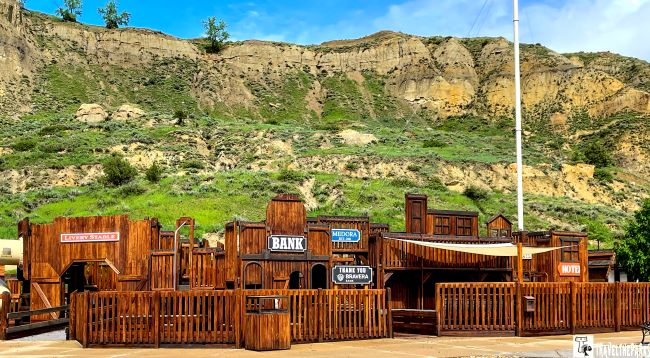
Stop #4-Medora Children’s Park
There’s a free, public playground at Medora Children’s Park open all year long. It’s got a western theme, with a faux town and a fort section. In the play areas, there’s a stagecoach and train engine that looks like they’re from the west. Children of all ages love the Medora Children’s Park. It’s got climbing, sliding, swinging, and balancing structures. We saw a few toddlers enjoying the sandbox before the rain began in earnest.

Stop #5-Harold Schafer Heritage Center
The Harold Schafer Visitor Center is a museum dedicated to Harold Schafer, a business owner who developed the “Mr. Bubble” and “Snowy Bleach” products. The multi-millionaire philanthropist we learned played a major role in the development of Medora. The Harold Schafer Visitor Center is open from 9:00 AM to 5:00 PM, seven days a week. Best of all, admission is FREE.

Stop #6-St. Mary’s Church
This is the oldest Catholic church still in use in the Bismarck Diocese, built in 1884 by Marquis de Mores. De Mores’ wife, Medora, was a devout Catholic, and she wanted to build a church in the town that was named after her. Keeping with the character of the era, St. Mary’s Church is made of red bricks with an elegant, simple design. A white wall and wooden pews decorate the church’s interior. A stained glass window shows the Virgin Mary.

Stop #7-J.A. Ferris Store
In 1883, Ferris built the J.A. Ferris Store to capitalize on Medora’s growing popularity. The docent inside was very friendly, chatting about the early days of Medora, when the J.A. Ferris Store was a big deal. The store sold lots of stuff, including groceries, clothing, and hardware. She told us the store was also a stagecoach stop, and served as a post office. Today, it’s a museum, and it’s free to visit. We found the inside exhibits detailed the store’s history, the Medora community, and the American West. I found some of the original store artifacts like a cash register, coffee grinder, and meat scale were pretty interesting.

Stop #8-De Mores Memorial Park
This small park was the last stop on our tour of the town. It is also home to a number of historical monuments, including a statue of Marquis de Mores, a replica of his log cabin, and a marker commemorating the site of his old cattle ranch. The one-mile trail is an easy walk. With rain on the horizon, we took a few minutes to sit on one of the park benches before the rain began. We had learned quite a bit of history of this charming gateway town on our tour.
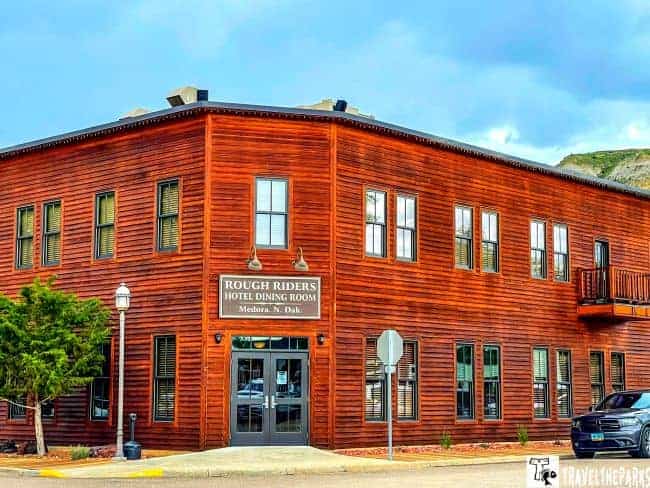
Where to Eat When Exploring Medora in TRNP
They built the historic Rough Riders Hotel in 1884. It is in the center of town and a popular location in the summer months. It is named after the Rough Riders, a volunteer cavalry regiment led by Theodore Roosevelt during the Spanish-American War. The hotel has original room accommodations that is in keeping with the olden times. However, it has all the modern amenities. Downstairs, we found Theodores’ dining room renowned for its elegant western atmosphere. The restaurant’s atmosphere, décor, and menu transport you back in time to the days of cowboys and cattlemen. TR’s Tavern features a large bar with a wide selection of beers, wines, and spirits. We ate our lunch in the upstairs portion of the restaurant to avoid the rain. Their signature Teddy’s Wagyu burger is a must-try for any fan of hearty, delicious food. The Walleye is also tasty.
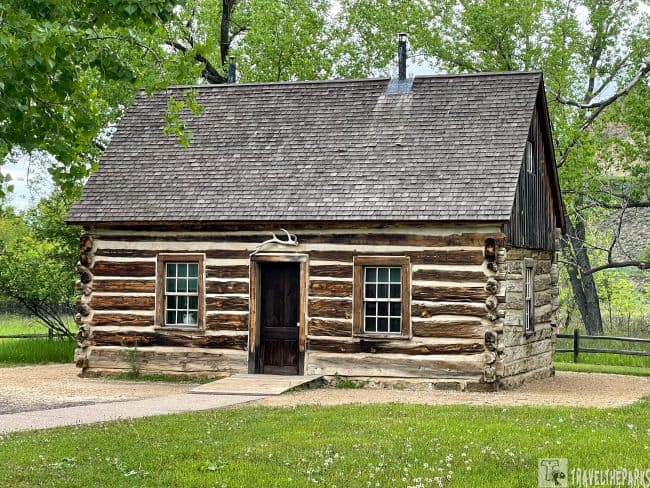
If you visit the Medora Musical, you can partake of the Pitchfork Steak Fondue. This is a rather unique and flavorful dish that combines the rustic charm of a cowboy cookout with the indulgence of a classic fondue. This hearty meal features tender chunks of steak skewered on pitchforks and cooked over an open fire, then dipped in a rich and savory fondue sauce. Tickets are a bit pricey, but it is the experience that matters.
We found the accommodations in Medora were costly so we stayed in an Airbnb in Belfield. Having arrived from the Black Hills in South Dakota, we felt it was kind of midpoint between the South Unit and North Unit. Not to mention it was way cheaper.

Final Thoughts: Exploring Medora: Gateway to Beautiful Theodore Roosevelt National Park
I must say, we found Medora to be a charming town in the Badlands of North Dakota. For us it was a great place to base yourself when exploring Theodore Roosevelt National Park. Medora offers a variety of attractions, including the Medora Musical, the North Dakota Cowboy Hall of Fame, and the Chateau de Mores State Historic Site. Exploring this little town has something to offer everyone, so it is sure to create a memorable day trip.
Have you been to the Badlands of North Dakota? Did you visit Medora? What did you like (or not like) about it?


